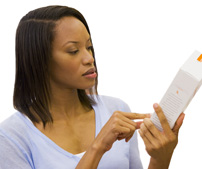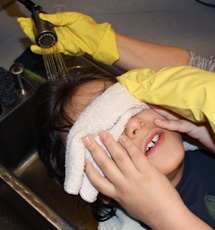Reducing Poisonings from Lice Control Treatments
Introduction

Lice are insects that can be found on the head, eyebrows, and eyelashes of people. They are not dangerous and they don't spread disease, but they do spread easily through head to head contact. They can also be spread through the sharing of personal items (such as hats, scarves, helmets, towels, and brushes).
Before using lice control products, make sure to take a few minutes to read and follow the package directions. Many of these products contain strong chemicals that can potentially be harmful.
By following a few simple tips you can limit your risk of exposure to potentially harmful chemicals and prevent a more serious health issue.
Symptoms of Head Lice Infestation
Some people may not experience any symptoms, but those who do, may experience:
- Itchy scalp.
- Small red bumps on the scalp, neck, and shoulders.
- Feeling of tickling or something crawling in the hair.
- Sores on the head caused by excessive scratching of the head.
Real Stories about Poisonings
A mom called the Poison Control Center. She had mistakenly given her 2-year old daughter 1 teaspoon of Lindane shampoo by mouth, instead of using it on the scalp.
What Went Wrong: The directions provided clear guidance about how and where to apply the product, but she assumed it was "medicine". Also, Lindane shampoo can have serious side effects, and should only be used in patients who cannot tolerate or have failed treatment with other medications.
An adult used lice control shampoo as a body wash from "head to toe." She left the product on her skin for 2 hours before rinsing, and developed swelling and a rash all over her body.
What Went Wrong: The product was not used properly. It is so important to read the directions and then follow them carefully.
A mom used lice control shampoo on her child. While rinsing, some of the product got in the child's eyes and caused redness, eye irritation and conjunctivitis.
What Went Wrong: The rinse water did not drain away from the face. Use a basin or sink and tilt the head back when rinsing out lice shampoo.
Additional Resources
- Reducing Pesticide Exposure, New York State Department of Health
- Lice Fact Sheet, New York State Department of Health
- What's Bugging You?, Cornell University
- Head Lice Prevention & Control, Centers for Disease Control & Prevention
- Head Lice Treatment, Centers for Disease Control & Prevention
Tips for Lice Control
Before Using Lice Control Products
- Contact your health care provider for treatment advice.
- Always read the product label first! The label provides important information about how much of the product to use and how often. Follow the directions carefully.
- Make sure you are using the correct product. Some products are for people; others just for bedding, furniture and carpets.
When Using Lice Control Products

- Wear gloves to prevent the product from coming into contact with skin.
- Do not use the product in the bath or shower.
- Wash hair in a sink with head tilted back so the product doesn't run into the eyes. Protect eyes by covering with a hand or towel.
- Do not treat more often than recommended on the label. Do not reapply sooner, or use more or keep it on longer than advised.
- If lice still exist, contact your health care provider for further treatment advice.

To Avoid Using Lice Control Products
- The #1 non-chemical treatment is combing, combing, combing. There are specially designed metal combs available to remove lice and eggs from the hair.
Avoid Re-Infestion of Lice
- Vacuum any areas or items (cars, furniture, and bedding) that may have been in contact with the infected person. Throw away the vacuum bag after use.
- Discourage children from sharing hats, scarves, combs, and brushes.
- Wash bed linen and clothing recently worn by infected people in hot water and then use a hot dryer.
- Routinely check your child's hair until the infestation is gone.
